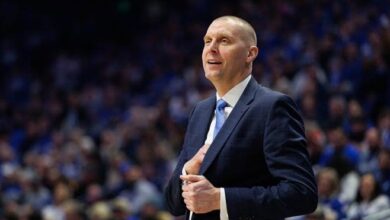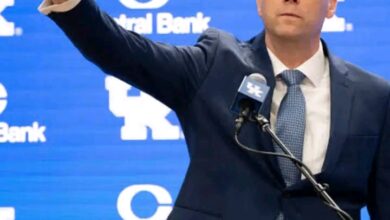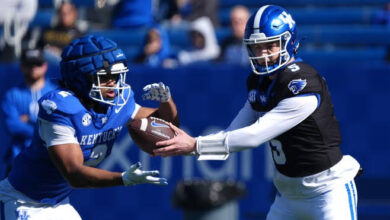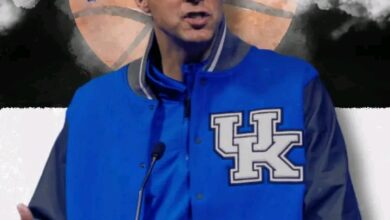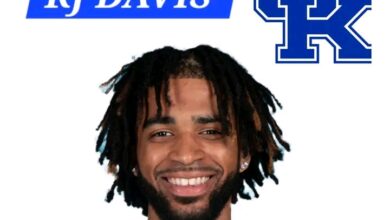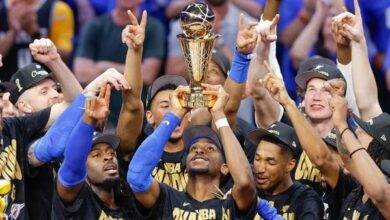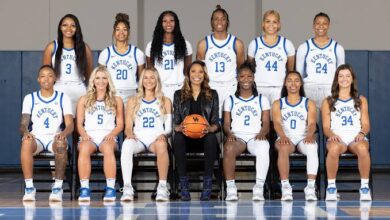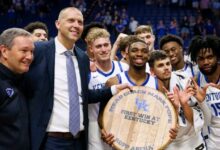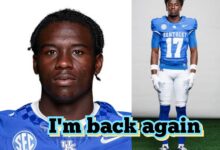UK WILDCAT FANS CALL FOR REVIVAL OF “BIG BLUE WALL” AS OFFENSIVE LINE STRUGGLES CONTINUE…
UK WILDCAT FANS CALL FOR REVIVAL OF “BIG BLUE WALL” AS OFFENSIVE LINE STRUGGLES CONTINUE...
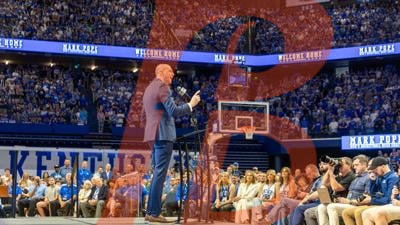
Once a cornerstone of Kentucky football, the Big Blue Wall now finds itself under fire from fans, analysts, and former players alike. The call is clear: it’s time to rebuild, reinforce, and reclaim dominance in the trenches.
Lexington, KY – The mood around the University of Kentucky football program has taken a shift. While optimism about new recruits and an evolving playbook still exists, an unmistakable concern dominates message boards, sports talk radio, and fan discussions across the Commonwealth: the offensive line.
The “Big Blue Wall,” once heralded as one of the SEC’s most formidable units, has faltered in recent seasons. Fans are demanding answers, and more importantly, solutions. There is growing consensus that the offensive line, long a source of pride for the Wildcats, must be addressed with urgency. Whether it’s through stronger recruiting, development of current players, or a reshuffle of the coaching staff, the message from Big Blue Nation is resounding—fix the Wall.
The Rise and Decline of the Big Blue Wall
From 2016 through 2020, Kentucky’s offensive line was among the most consistent in the Southeastern Conference. Under former offensive line coach John Schlarman, the Wildcats forged a physical, punishing identity, producing multiple NFL draft picks like Logan Stenberg and Drake Jackson. The “Big Blue Wall” wasn’t just a catchy nickname—it was a culture.
But since Schlarman’s tragic passing in 2020 and subsequent transitions in the coaching staff, that culture has struggled to survive. While flashes of brilliance remain, Kentucky’s front line has lacked consistency, chemistry, and the raw physicality that once defined it. In the 2023 and 2024 seasons, sacks increased, rushing yards dipped, and protection breakdowns became all too familiar.
“We used to dominate teams in the trenches,” said former UK offensive lineman Larry Warford. “Now, we’re playing catch-up. That’s not who we are.”
Statistical Snapshot: What the Numbers Say
The numbers are stark. In 2022, Kentucky allowed 47 sacks, ranking near the bottom in the SEC. In 2023, that number only marginally improved. The rushing offense, once top-5 in the conference, fell to 10th in average yards per game last season. These stats aren’t just numbers—they reflect a deeper erosion of what once made Kentucky football uniquely competitive.
Pro Football Focus (PFF) graded the Wildcats’ 2024 offensive line in the bottom third nationally in both run-blocking and pass protection. For a team priding itself on physicality, that’s a tough pill to swallow.
Recruiting Concerns: Missing the Mark on Elite Talent
One of the primary criticisms from fans centers on the recruitment pipeline. During the Big Blue Wall’s prime years, Kentucky consistently landed 4-star linemen and developed them into pro-ready players. But recent recruiting cycles have seen top offensive line prospects choosing other SEC schools or programs with stronger NIL packages and perceived development pathways.
“There’s no excuse for missing out on top in-state linemen,” tweeted one fan. “We’ve got talent in Kentucky and nearby states, but we’re not closing the deal.”
Indeed, Kentucky has lost key battles for linemen in Ohio, Georgia, and Tennessee. While the 2025 recruiting class shows promise, fans want to see more than potential—they want proven commits who can start early and impact games.
The Coaching Conundrum: Is It Time for a Change?
One of the most debated topics is the current offensive line coaching situation. After Schlarman’s passing, Kentucky hired Eric Wolford, followed by Zach Yenser. While both have strong resumes, fan confidence in the current coaching setup is waning.
“We’ve seen regression, not progression,” said Mark Bryant, a season ticket holder of 17 years. “Something has to change—whether it’s technique, scheme, or the entire coaching approach.”
There’s also discussion about bringing in a co-offensive line coach or a consultant, potentially someone with NFL experience, to help modernize blocking schemes and improve fundamentals.
Former players have chimed in, too. “It’s not just about getting five big guys,” said Logan Stenberg during an interview on a local radio show. “It’s about cohesion, mentality, and teaching the little things—hand placement, footwork, leverage. You lose that, and you lose games.”
Developmental Setbacks: Where’s the Growth?
Even when Kentucky has brought in decent talent, player development appears to have plateaued. Redshirt freshmen aren’t progressing into starters at the expected rate. Sophomores and juniors look overwhelmed by elite SEC defensive lines. The once-notorious Kentucky run game now looks pedestrian, with too many tackles for loss and failed conversions on third-and-short.
Analysts have pointed out the lack of identity. “Kentucky used to have a power-running ethos, and the O-line was built around that,” said SEC Network analyst Cole Cubelic. “Now, it feels like they’re trying to do too many things without doing any of them particularly well.”
Fans echo this sentiment, asking the staff to return to basics and rebuild a singular offensive identity rooted in physical dominance up front.
Fan Mobilization: The Big Blue Wall Movement
Social media has become a hub for fan campaigns under hashtags like #FixTheWall and #RebuildTheBlue. Influential UK fan accounts are organizing message blasts, encouraging fans to write to the athletic department, and pushing for more transparency on offensive line plans.
A Change.org petition titled “Bring Back the Big Blue Wall” has already amassed over 8,000 signatures, demanding that UK Athletics prioritize the offensive line in strategic planning and recruiting budgets.
Students are getting involved too. The UK Student Government Association is reportedly considering a resolution to support increased investment in O-line development. For many fans, the Big Blue Wall isn’t just a unit—it’s a representation of Kentucky’s identity.
Former Players and Analysts Weigh In
A stream of former Kentucky offensive linemen have begun speaking publicly, urging the program to recommit to trench warfare.
“I’ll always bleed blue, but we’ve got to be honest,” said former All-American Bunchy Stallings in an interview with The Courier-Journal. “If we want to compete with Georgia, Tennessee, Alabama, we can’t just hope. We need a plan. We need urgency.”
ESPN analyst Kirk Herbstreit also touched on the issue during a recent College Football Live segment, noting that Kentucky’s offensive inconsistency has “everything to do with that offensive line.”
Mark Stoops’ Response: “We Hear You”
Head Coach Mark Stoops has acknowledged the criticism. During a recent press conference, he addressed fan frustrations directly:
“We built this program on physicality, on the Big Blue Wall. We know we’ve taken some steps back, and I want our fans to know—it matters to us. We’re already evaluating every aspect: recruiting, coaching, and development.”
Sources close to the program suggest Stoops is actively considering internal restructuring. There are whispers of a possible analyst hire this offseason with a specific focus on offensive line performance metrics and fundamentals.
Looking Ahead: What’s Next for Kentucky Football?
The stakes are high. With a promising 2025 quarterback class and several talented running backs already committed, the offensive line remains the lynchpin. Without significant improvement, Kentucky’s offensive potential will remain unrealized.
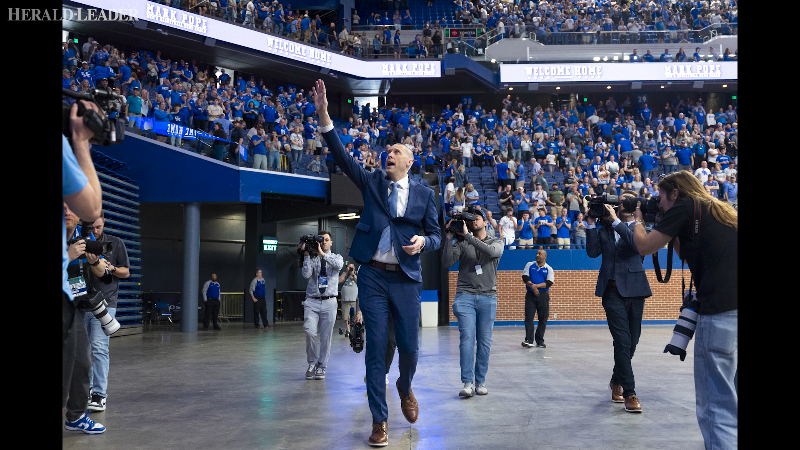
Here’s what fans, analysts, and insiders are demanding:
- Stronger Recruiting: Kentucky must compete harder for top regional and national O-line talent. That may mean enhanced NIL offerings, better recruiting strategy, and more personal engagement from top staff.
- Enhanced Development: Implementing a development pipeline similar to programs like Iowa or Wisconsin, known for consistently producing pro-level linemen.
- Coaching Evaluation: A deep-dive into the coaching structure, considering everything from blocking schemes to strength training and player feedback.
- Transparent Communication: Fans want to know the program’s direction and how leadership plans to restore the Wall.
The Heart of the Matter: Culture and Commitment
Ultimately, what’s at stake is more than wins or statistics. It’s about culture. For many in Big Blue Nation, the Big Blue Wall was a symbol of Kentucky grit—understated, tough, reliable. A unit that didn’t seek headlines but earned respect. A group that embodied the blue-collar spirit of the Commonwealth.
If Kentucky wants to return to SEC contention, rebuilding that wall is non-negotiable.
“There’s no path forward without the Wall,” said former UK running back Benny Snell. “We can talk about QBs, receivers, new plays—but none of it works without those five guys doing their job.”
Conclusion: A Rebuilding Year With High Expectations
The 2025 season is being framed by many as a turning point. Whether it’s new hires, tactical shifts, or a breakout recruiting class, Kentucky must show real improvement in the trenches.
Big Blue Nation has made its voice clear: the offensive line isn’t just another position group—it’s the soul of the team. And if Kentucky hopes to compete in the SEC’s upper tier again, the revival of the Big Blue Wall must become priority number one.

